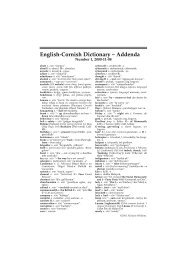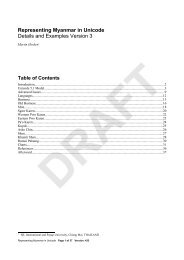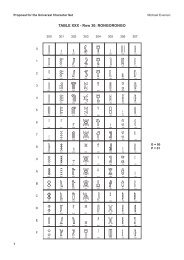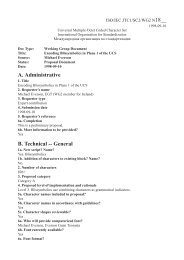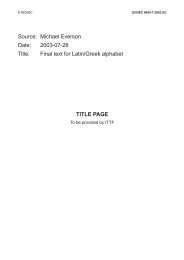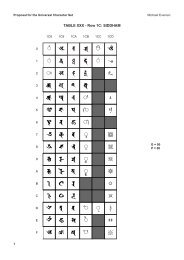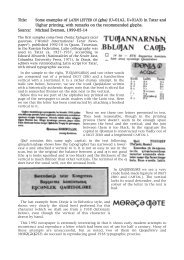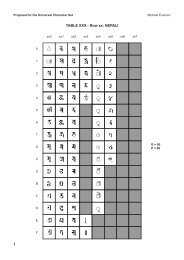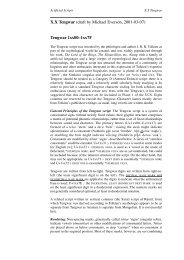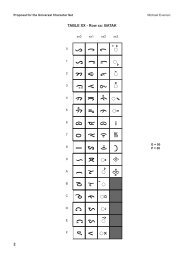Towards a Proposal to encode Egyptian Hieroglyphs in ... - Evertype
Towards a Proposal to encode Egyptian Hieroglyphs in ... - Evertype
Towards a Proposal to encode Egyptian Hieroglyphs in ... - Evertype
You also want an ePaper? Increase the reach of your titles
YUMPU automatically turns print PDFs into web optimized ePapers that Google loves.
numbers <strong>to</strong> them? Is reta<strong>in</strong><strong>in</strong>g these <strong>in</strong> order <strong>to</strong> have a 1:1 representation as characters of all signs with<br />
catalog numbers an important goal, or should the encod<strong>in</strong>g assume modern font technology where such<br />
forms would be represented by unnamed glyphs? How are these used? Do they occur as such <strong>in</strong> exist<strong>in</strong>g<br />
data so that cross-mapp<strong>in</strong>g <strong>to</strong> Unicode is an important issue?<br />
13.5. Issue: Numbers. The encod<strong>in</strong>g for numbers proposed has met some opposition on the grounds that<br />
these represent precomposed characters. In this situation it would be useful <strong>to</strong> hear from practioners and<br />
people familiar with other efforts <strong>to</strong> <strong>encode</strong> the numbers. Are there issues with transcod<strong>in</strong>g from exist<strong>in</strong>g<br />
data collections.<br />
13.6. Miscellaneous issues: Gard<strong>in</strong>er dist<strong>in</strong>guishes ˝ N034 from ˛ N034-A: G1957:545:N34,<br />
G1928:31:N34, G1931:246:N34*, and G1953:4:N34*. Allen dist<strong>in</strong>guishes ˇ N034-B: A1999:437:N34a.<br />
Is this correct? Most of Gard<strong>in</strong>er’s “Ff” series, “Signs for transcription from Hieratic” are clearly<br />
identified as variants of other signs, and have been <strong>encode</strong>d as such. Two of them, é FF008 and<br />
è FF008-A have not yet been attested with certa<strong>in</strong>ty, but when they are they should be renamed and filed<br />
next <strong>to</strong> what they are variants of. Should Old K<strong>in</strong>gdom signs such as ‰ and Â, found at G1957:479:M3, be<br />
<strong>encode</strong>d at this time or left for future standardization?<br />
14. Bibliography<br />
Allen, James P. 1999. Middle <strong>Egyptian</strong>: an <strong>in</strong>troduction <strong>to</strong> the language and culture of <strong>Hieroglyphs</strong>.<br />
Cambridge: Cambridge University Press. ISBN 0-521-77483-7<br />
Collier, Mark, and Bill Manley. 1998. How <strong>to</strong> read <strong>Egyptian</strong> hieroglyphs: a step-by-step guide <strong>to</strong> teach<br />
yourself. [London]: British Museum Press. ISBN 0-7141-1910-5<br />
Cook, Richard, Michael Everson, Rick McGowan, & Robert Richmond. 2005-10-24. L2/05-311 Revised<br />
proposal <strong>to</strong> <strong>encode</strong> <strong>Egyptian</strong> hieroglyphs <strong>in</strong> Plane 1.<br />
Everson, Michael. 1997-08-25. N1636 Encod<strong>in</strong>g <strong>Egyptian</strong> <strong>Hieroglyphs</strong> <strong>in</strong> ISO/IEC 10646-2.<br />
http://www.dkuug.dk/JTC1/SC2/WG2/docs/n1636/n1636.htm<br />
Everson, Michael. 1999-01-09. N1944 Encod<strong>in</strong>g <strong>Egyptian</strong> <strong>Hieroglyphs</strong> <strong>in</strong> Plane 1 of the UCS.<br />
http://www.dkuug.dk/JTC1/SC2/WG2/docs/n1944.pdf<br />
Faulkner, Raymond O. 1986 (1962). A concise dictionary of Middle <strong>Egyptian</strong>. Oxford: Griffith Institute.<br />
ISBN 0-900416-32-7<br />
Gard<strong>in</strong>er, Alan H. 1928. Catalogue of the <strong>Egyptian</strong> hieroglyphic pr<strong>in</strong>t<strong>in</strong>g type, from matrices owned and<br />
controlled by Dr. Alan H. Gard<strong>in</strong>er, <strong>in</strong> two sizes, 18 po<strong>in</strong>t, 12 po<strong>in</strong>t with <strong>in</strong>termediate forms. Oxford:<br />
Oxford University Press.<br />
Gard<strong>in</strong>er, Alan H. 1929. “Additions <strong>to</strong> the new hieroglyphic fount (1928)”, <strong>in</strong> The Journal of <strong>Egyptian</strong><br />
Archaeology 15, p. 95. London: Egypt Exploration Society<br />
Gard<strong>in</strong>er, Alan H. 1931. “Additions <strong>to</strong> the new hieroglyphic fount (1931)”, <strong>in</strong> The Journal of <strong>Egyptian</strong><br />
Archaeology 17, pp. 245-247. London: Egypt Exploration Society<br />
Gard<strong>in</strong>er, Alan H. 1953. Supplement <strong>to</strong> the catalogue of the <strong>Egyptian</strong> hieroglyphic pr<strong>in</strong>t<strong>in</strong>g type, show<strong>in</strong>g<br />
acquisitions <strong>to</strong> December 1953. Oxford: Oxford University Press.<br />
Gard<strong>in</strong>er, Alan H. 1957. <strong>Egyptian</strong> grammar: be<strong>in</strong>g an <strong>in</strong>troduction <strong>to</strong> the study of hieroglyphs. 3rd<br />
edition. London: Oxford University Press.<br />
Grimal, Nicolas, Jochen Hallof, & Dirk van der Plas. 1993. Hieroglyphica. Volume 1: Sign list – Liste des<br />
signes – Zeichenliste. (Publications <strong>in</strong>teruniversitaires de recherches égyp<strong>to</strong>logiques <strong>in</strong>formatisées).<br />
Utrecht & Paris: Centre for Computer-aided Egyp<strong>to</strong>logical Research. ISBN 90-393-0207-3.<br />
Grimal, Nicolas, Jochen Hallof, & Dirk van der Plas. 2000. Hieroglyphica. Volume 1 2 : Sign list – Liste<br />
des signes – Zeichenliste. Second edition, revised and enlarged by Jochen Hallof, Hans van den Berg,<br />
Gabriele Hallof. (Publications <strong>in</strong>teruniversitaires de recherches égyp<strong>to</strong>logiques <strong>in</strong>formatisées). Utrecht<br />
& Paris: Centre for Computer-aided Egyp<strong>to</strong>logical Research. ISBN 90-393-2349-6.<br />
9





